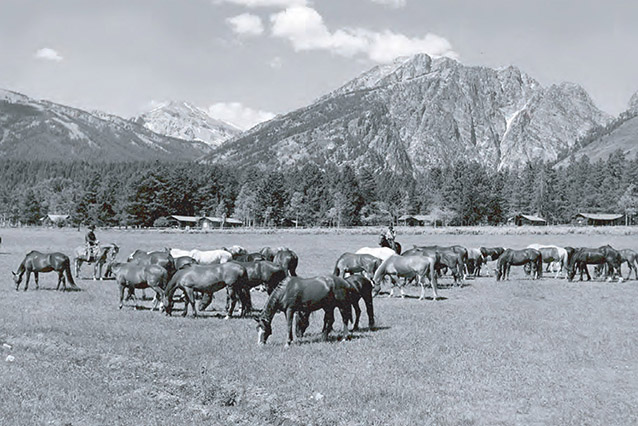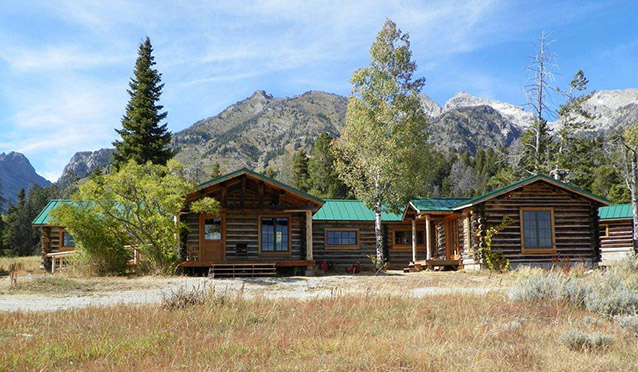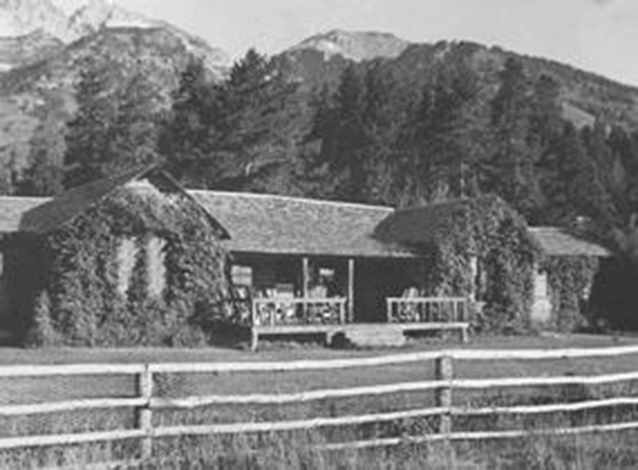White Grass Ranch occupies roughly 320 acres of land in the upper Snake River Valley, in the area known as Jackson Hole, Wyoming. It was the third dude ranch established in what is now Grand Teton National Park. Preservation work began in 2005 to adaptively reuse the ranch for the Western Center for Historic Preservation, where NPS employees and volunteers learn preservation techniques and practice skills.
The White Grass Dude Ranch helped define the standards for the local Jackson Hole dude ranch industry. The district exemplifies local development from cattle ranches to dude ranches. It was the longest-lived active dude ranch in Jackson Hole.

NPS
Harold Hammond, a westerner, began to develop the ranch in 1913, when he filed a 160 acre homestead claim within the boundary of the Teton National Forest. Between 1913 and 1923, he and his partner, George Tucker Bispham, a transplant from Philadelphia, made improvements to their adjacent homestead claims and received their patents in 1920 and 1923, respectively. By around 1919, they had begun accepting paying guests to their ranches, accommodating them in three log houses.
The first two decades of the ranch operation were supplemented through other endeavors, including a silver fox farm. Between 1923 and 1928, Hammond and Bispham deeded their claims to Bar BC Ranches, Inc., a partnership consisting of themselves, Struthers Burt and Horace Carncross (founders of the Bar BC Ranch), and Irving Corse and Sinclair Armstrong. During this partnership, White Grass was designated the White Grass Ranch for Boys; Hammond and Armstrong were identified as the directors of the ranch.

NPS
Thirteen more cabins and a swimming pool were added to the site during this era. In 1928, both Hammond and Bispham withdrew from the partnership, and the property was deeded back to the original patentees. Almost immediately thereafter, Hammond bought out Bispham, including all of the property, buildings, and furnishings.
For the next decade Hammond owned and operated the 320 acre dude ranch, with the help of his first and second wives. During that time, agricultural operations at the ranch included about fifty head of cattle, irrigating, and haying. Improvements to the ranch included the construction of a separate bathhouse, and eventually bathrooms were added to some of the dude cabins.
After Hammond’s death in 1939, his stepson, Frank Galey, assumed management of the ranch. Galey continued the operation until his death in 1985, making it the longest lived active dude ranch in Jackson Hole. During Galey’s era, he continued to make improvements at the ranch, including multiple frame additions on the cabins. In 1956, Frank and his wife Inge Galey sold White Grass Ranch to the National Park Service, with a lifetime estate agreement that permitted family to use the property into the 1980s.

NPS
When Frank Galey died in July 1985, the National Park Service began planning for future management of the site. The initial response toward management of the property was to restore the site to its natural conditions. Between the late 1980s and early 1990s, the park sold several of the cabins, removed the constructed water features and ranch fencing, and boarded up remaining buildings.
In 2003, the National Trust for Historic Preservation and the NPS entered into an agreement to rehabilitate the White Grass Dude Ranch for use as a regional preservation training center. The buildings and structures of the site offer trainees hands-on preservation experience in historic building stabilization and rehabilitation techniques.
The White Grass Dude Ranch is significant in conjunction with the Bar BC and JY ranches, as the three ranches helped define and set the standards for the local dude ranch industry in Jackson Hole. The ranch also exemplifies the evolution and development of local cattle ranches into dude ranches. Overall, the site retains several landscape features and patterns that were developed in the early and mid-twentieth century.
Quick Facts
- Cultural Landscape Type: Vernacular
- National Register Significance Level: Local
- National Register Significance Criteria: A
- Period of Significance: 1919-1970
Landscape Links
Last updated: January 2, 2020
